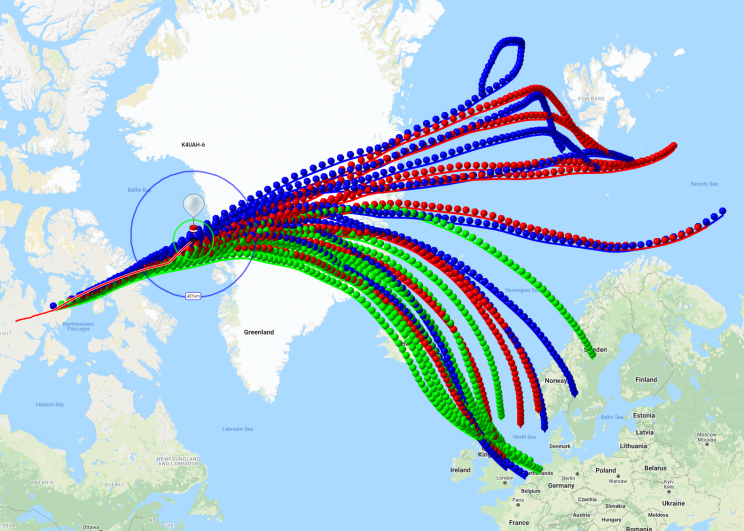ARL Weekly News – July 16, 2021
| Recent Events |
R2O Conference presentation
Youhua Tang attended the first UFS R2O (NOAA Unified Forecast System Research to Operation) Annual Meeting, July 12-15, as the PI of JTTI FY20 aerosol data assimilation (DA) project. His presentation titled “Recent Progress of JTTI FY20 Aerosol Data Assimilation in Support of RRFS-CMAQ” showed the recent progress of aerosol DA and its significant improvement of modeled surface PM2.5 (particle matter with diameter < 2.5 micrometer) bias using the Joint Effort for Data assimilation Integration (JEDI) for the new inline regional air quality model, RRFS-CMAQ (Rapid Refresh Forecast System with CMAQ chemical mechanism). He and his teammates will continue this work to improve this system.
Record Temperatures recorded at Stovepipe Wells, CA USCRN Station
Dr. Howard Diamond, program manager of the U.S. Climate Reference Network (USCRN), reports that an all-time USCRN maximum temperature was set on Sunday July 11, 2021 at the station in Stovepipe Wells, CA with a record of 128.6°Fahrenheit; that coupled with the highest ever daily minimum temperature recorded in North America of 107.7°F (and second most globally), resulted in the highest ever average daily temperature ever observed on the planet of 118.1°F as depicted in the hourly temperature profile depicted below. The Stovepipe Wells site is a couple of miles away from the National Park Service’s observing site in the Death Valley site at Furnace Creek, and usually reports a couple of degrees cooler than the Furnace Creek site. The records will still have to be evaluated by the State Climate Extremes Committee at NOAA’s National Centers for Environmental Information as well as the World Meteorological Organization’s (WMO) Rapporteur on Climate Extremes who documents such records at the WMO’s World Weather Archive and Climate Extremes website at https://wmo.asu.edu/.

July 11, 2021 temperature data from Stovepipe Wells, CA US CRN Station
This event from the USCRN station in Stovepipe Wells was recognized in an article in the Washington Post on July 12th at https://www.washingtonpost.com/weather/2021/07/12/death-valley-record-heat-earth/. This data demonstrates the utility of the USCRN as it continues in its mission of documenting climate change across the US. The USCRN is managed, maintained, and operated by OAR’s Air Resources Laboratory, and partners with NESDIS’ National Centers for Environmental Information for the critical data management aspects of the USCRN.
| Recent News |
NOAA Upgrades Key Air Quality Prediction Model
Congratulations to ARL’s Youhua Tang, Barry Baker and Patrick Campbell (along with Rick Saylor and Pius Lee and a range of NOAA colleagues), who delivered significant updates to the Air Quality Model that NOAA’s National Weather Service uses to deliver air quality forecast guidance. NOAA’s partnership with the Environmental Protection Agency (EPA) issues daily air quality forecast guidance as part of a National Air Quality Forecasting Capability. These forecasts include information such as the levels of ozone, smoke, dust and fine particulate matter (PM2.5) in the air we breathe.
When ARL intern Todd McKinney sat down to analyze his University’s super high pressure balloon satellite, K4UAH-6, as it was about to make a pass over Greenland, the high pressure cells gave a range of artful results.

The ASH team continues to monitor their in-flight balloon satellite. On the 130th mission day, the K4UAH-6 balloon travelled through Greenland on July 16, 2021. Due to the large high and low pressure systems that are positioned over Greenland and the Norwegian Sea, early HYSPLIT-calculated trajectories show many possible trajectories over the next coming days. The difference in trajectories are due to projected uncertainties in the meteorological forecast for the region.
| Recent Publications |
Application of bulk Richardson parameterizations of surface fluxes to heterogeneous land surfaces
A paper by Temple Lee, Michael Buban, and Tilden Meyers entitled ”Application of bulk Richardson parameterizations of surface fluxes to heterogeneous land surfaces” is now available in Monthly Weather Review. In the paper, we demonstrated that using a bulk Richardson approach yielded predictions of friction velocity, sensible heat flux, and latent heat flux that were just as good as, and in some instances better, than predictions of these quantities obtained when using long-standing similarity relationships derived from Monin-Obukhov Similarity Theory. The results presented in this paper result motivate us to consider implementing the bulk Richardson approach into numerical weather prediction models, as doing so is expected to improve surface-layer parameterization schemes used within these models.
Preprint now available: https://doi.org/10.1175/MWR-D-21-0047.

